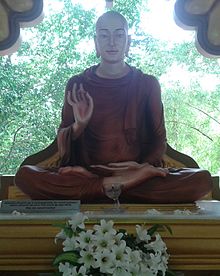Arahant Mahinda Thera
| Mahinda | |
|---|---|

An Arhat Mahinda Statue at a Monastery
|
|
| Religion | Buddhism |
| Sect | Theravada |
| Known for | Establishing Theravāda Buddhism in Sri Lanka |
| Education | Buddhist religion |
| Personal | |
| Nationality | Indian |
| Born | Mahendra (Sanskrit) In the 3rd century B.C. Ujjeni, Ashokan Period, India |
| Died | Anuradhapura, Sri Lanka |
| Cause of death | Senescence |
| Resting place | Sri Lanka |
| Parents |
Ashoka (father) Devi (mother) |
Mahinda (Sanskrit Mahendra; born third century BCE in Ujjain, modern Madhya Pradesh, India) was a Buddhist monk depicted in Buddhist sources as bringing Buddhism to Sri Lanka. He was the first-born son of the Mauryan emperor Ashoka from his wife Devi and the elder brother of Sanghamitra.
Ashoka named him Mahendra, meaning "conqueror of the world". But Mahendra, inspired by his mother, became a Buddhist monk.
The Dipavamsa and the Mahavamsa, Sri Lanka's two great religious chronicles, contain accounts of Mahinda travelling to Sri Lanka and converting King Devanampiyatissa. These are the primary sources for accounts of his life and deeds. Inscriptions and literary references also establish that Buddhism became prevalent in Sri Lanka around the 3rd century BCE, the period when Mahinda lived.
The Mahavamsa says that Mahinda, the son of Ashoka, came to Sri Lanka and that Ashoka's daughter became a nun and brought the Bodhi Tree. But not only does Ashoka not mention them, but there aren't any sculptures or frescoes of them in the earliest period of Singhalese art. Even the most ancient stupas on Mihintale don't contain anything like this.
The historical accuracy of Mahinda converting the Sri Lankan king to Buddhism is also debated. Professor Hermann Oldenberg, a German scholar of Indology who has published studies on the Buddha and translated many Pali texts, considers this story a "pure invention". V. A. Smith (Author of Ashoka and Early history of India) also refers to this story as "a tissue of absurdities". V. A. Smith and Professor Hermann came to this conclusion due to Ashoka not mentioning the handing over of his son, Mahinda, to the temple to become a Buddhist missionary and Mahinda's role in converting the Sri Lankan king to Buddhism, in his 13th year Rock Edicts, particularly Rock-Edict XIII.
...
Wikipedia
